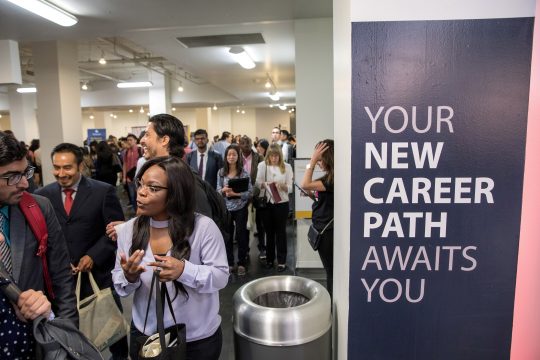WASHINGTON, (Reuters) - U.S. employers hired the most workers in 10 months in December while boosting wages, which could help to allay a recent upsurge in fears about the economy's health that has roiled financial markets.
The upbeat employment report from the Labor Department on Friday stood in stark contrast with reports this week showing Chinese factory activity contracting for the first time in 19 months in December and weak manufacturing across much of Europe and Asia.
Concerns about the economy had been boosted by surveys showing sharp declines in consumer confidence and manufacturing activity last month. Both were seen as more red flags that the economic expansion, now in its ninth year and the second longest on record, is losing steam.
Nonfarm payrolls increased by 312,000 jobs last month, the largest gain since February, as employment at construction sites snapped back after being restrained by unseasonably cold temperatures in November. There were also broad gains in hiring last month.
Data for October and November were revised to show 58,000 more jobs added than previously reported. The economy created 2.6 million jobs last year compared to 2.2 million in 2017.
Average hourly earnings rose 11 cents, or 0.4 percent, in December after gaining 0.2 percent in November. That lifted the annual increase in wages to 3.2 percent, matching October's gain, from 3.1 percent in November.
The unemployment rate increased to 3.9 percent from a near 49-year low of 3.7 percent in November as a strong labor market lured some jobless Americans from the sidelines. The labor force participation rate, or the proportion of working-age Americans who have a job or are looking for one, rose to 63.1 percent last month from 62.9 percent in November.
The December jobs gain pushed total U.S. employment above 150 million jobs for the first time.
The Labor Department has not been affected by the partial shutdown of the U.S. government and will continue to publish economic data complied by its statistics agency, the Bureau of Labor Statistics.
Data releases from Census Bureau and Bureau of Economic Analysis have been suspended during the shutdown, which started on Dec. 22 amid demands by President Donald Trump for $5 billion in border wall funding.
The strong employment report likely keeps the Federal Reserve on course to continue raising interest rate this year, deepening its rift with Wall Street and Trump, who has chastised the Fed and its chairman, Jerome Powell, repeatedly for the rate increases. Powell is due to appear on a panel with his two predecessors about two hours after the report's release.
The U.S. central bank raised rates four times in 2018. The Fed last month forecast two rate hikes this year and signaled its tightening cycle is nearing an end in the face of financial market volatility and slowing global growth.
U.S. financial markets are projecting no rate hikes in 2019. In the latest signal that investors see little room for the Fed to lift rates any further, yields on 2-year U.S. Treasury notes <US2YT=RR> on Thursday dropped below the Fed's policy rate for the first time in more than a decade.
The S&P 500 index <.SPX> suffered its worst December since the Great Depression and tumbled on Thursday after Apple Inc <AAPL.O> slashed its holiday-quarter revenue forecast, saying sales in China slowed more than expected.
Growth forecasts for the fourth quarter are around a 2.6 percent annualized rate, with risks tilted to the downside amid fading stimulus from the Trump administration's $1.5 trillion tax cut package, a trade war with China and policy uncertainty in Washington.
The economy grew at a 3.4 percent pace in the third quarter. It needs to create roughly 100,000 jobs per month to keep up with growth in the working-age population.
With the labor market viewed as at or beyond full employment, job growth is expected to slow this year as workers become more scarce. Anecdotal evidence has been growing of companies experiencing difficulties finding workers, and raising wages to retain and attract employees.
There are concerns that tightening financial market conditions because of the steep stock market sell-off could hurt hiring. The government shutdown, if it extends beyond next week, could weigh on January payrolls.
Hiring last month rose across all sectors. Retail employment increased by 23,800 jobs. Employment at construction sites rebounded last month, with companies hiring 38,000 employees after adding no workers in November.
Manufacturing payrolls increased by 32,000 jobs in December, but could surprise on the downside after a measure of factory employment fell last month.
Professional and business services employment increased by 43,000 jobs last month and government payrolls rose 11,000.
(Reporting by Lucia Mutikani Editing by Dan Burns and Paul Simao)
